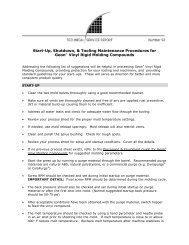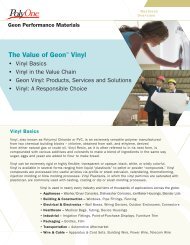PolyOne 2009 Annual Report
PolyOne 2009 Annual Report
PolyOne 2009 Annual Report
Create successful ePaper yourself
Turn your PDF publications into a flip-book with our unique Google optimized e-Paper software.
manufacturing sites and 11 distribution facilities in North America,<br />
Europe and Asia, and joint ventures in North America. We offer more<br />
than 35,000 polymer solutions to over 10,000 customers across<br />
the globe. In <strong>2009</strong>, we had sales of $2.1 billion, 37% of which were<br />
to customers outside the United States.<br />
We provide value to our customers through our ability to link our<br />
knowledge of polymers and formulation technology with our manufacturing<br />
and supply chain processes to provide an essential link<br />
between large chemical producers (our raw material suppliers) and<br />
designers, assemblers and processors of plastics (our customers).<br />
We believe that large chemical producers are increasingly outsourcing<br />
less-than-railcar business; polymer and additive producers need<br />
multiple channels to market; processors continue to outsource<br />
compounding; and international companies need suppliers with<br />
global reach. Our goal is to provide our customers with specialized<br />
material and service solutions through our global reach, product<br />
platforms, low-cost manufacturing operations, a fully integrated<br />
information technology network, broad market knowledge and raw<br />
material procurement leverage. Our end markets are primarily in the<br />
building and construction materials, wire and cable, transportation,<br />
durable goods, packaging, electrical and electronics, medical and<br />
telecommunications markets, as well as many industrial<br />
applications.<br />
<strong>PolyOne</strong> was formed on August 31, 2000 from the consolidation<br />
of The Geon Company (Geon) and M.A. Hanna (Hanna). Geon’s<br />
roots date back to 1927 when BFGoodrich scientist Waldo Semon<br />
produced the first usable vinyl polymer. In 1948, BFGoodrich created<br />
a vinyl plastic division that was subsequently spun off through<br />
a public offering in 1993, creating Geon, a separate publicly-held<br />
company. Hanna was formed in 1885 as a privately-held company<br />
and became publicly-held in 1927. In the mid-1980s, Hanna began<br />
to divest its historic mining and shipping businesses to focus on<br />
polymers. Hanna purchased its first polymer company in 1986 and<br />
completed its 26th polymer company acquisition in 2000.<br />
Polymer Industry Overview<br />
Polymers are a class of organic materials that are generally<br />
produced by converting natural gas or crude oil derivatives into<br />
monomers, such as ethylene, propylene, vinyl chloride and styrene.<br />
These monomers are then polymerized into chains called polymers,<br />
or plastic resin, in its most basic form. Large petrochemical companies,<br />
including some in the petroleum industry, produce a majority<br />
of the monomers and base resins because they have direct<br />
access to the raw materials needed for production. Monomers<br />
make up the majority of the variable cost of manufacturing the base<br />
resin. As a result, the cost of a base resin tends to move in tandem<br />
with the industry market prices for monomers and the cost of raw<br />
materials and energy used during production. Resin selling prices<br />
can move in tandem with costs, but are largely driven by supply and<br />
demand balances. Through our equity interest in SunBelt Chlor-<br />
Alkali Partnership (SunBelt), we realize a portion of the economic<br />
benefits of a base resin producer for PVC resin, one of our major raw<br />
materials.<br />
Thermoplastic polymers make up a substantial majority of the<br />
resin market and are characterized by their ability to be reshaped<br />
repeatedly into new forms after heat and pressure are applied.<br />
Thermoplastics offer versatility and a wide range of applications.<br />
The major types of thermoplastics include polyethylene, polyvinyl<br />
chloride, polypropylene, polystyrene, polyester and a range of specialized<br />
engineering resins. Each type of thermoplastic has unique<br />
qualities and characteristics that make it appropriate for use in a<br />
particular product.<br />
Thermoplastic resins are found in a number of end-use products<br />
and in a variety of markets, including packaging, building and<br />
construction, wire and cable, transportation, medical, furniture and<br />
furnishings, durable goods, institutional products, electrical and<br />
electronics, adhesives, inks and coatings. Each type of thermoplastic<br />
resin has unique characteristics (such as flexibility, strength or<br />
durability) suitable for use in a particular end-use application. The<br />
packaging industry, the largest consumer of plastics, requires<br />
plastics that help keep food fresh and free of contamination while<br />
providing a variety of options for product display, and offering<br />
advantages in terms of weight and user-friendliness. In the building<br />
and construction industry, plastic provides an economical and<br />
energy efficient replacement for other traditional materials in piping<br />
applications, siding, flooring, insulation, windows and doors, as well<br />
as structural and interior or decorative uses. In the wire and cable<br />
industry, thermoplastics serve to protect by providing electrical<br />
insulation, flame resistance, durability, water resistance, and color<br />
coding to wire coatings and connectors. In the transportation industry,<br />
plastic has proved to be durable, lightweight and corrosion<br />
resistant while offering fuel savings, design flexibility and high<br />
performance. In the medical industry, plastics help save lives by<br />
safely providing a range of transparent and opaque thermoplastics<br />
that are used for a vast array of devices including blood and intravenous<br />
bags, medical tubing, masks, lead replacement for radiation<br />
shielding, clamps and connectors to bed frames, curtains and<br />
sheeting, and electronic enclosures. In the electronics industry,<br />
plastic enclosures and connectors not only enhance safety through<br />
electrical insulation, but thermally and electrically conductive plastics<br />
provide heat transferring, cooling, antistatic, electrostatic discharge,<br />
and electromagnetic shielding performance for critical<br />
applications including integrated circuit chip packaging.<br />
Various additives can be combined with a base resin to provide<br />
it with greater versatility and performance. These combinations are<br />
known as plastic compounds. Plastic compounds have advantages<br />
over metals, wood, rubber and other traditional materials, which<br />
have resulted in the replacement of these materials across a wide<br />
spectrum of applications that range from automobile parts to construction<br />
materials. Plastic compounds offer advantages compared<br />
to traditional materials that include processability, weight reduction,<br />
chemical resistance, flame retardance and lower cost. Plastics<br />
have a reputation for durability, aesthetics, ease of handling and<br />
recyclability.<br />
POLYONE CORPORATION<br />
3



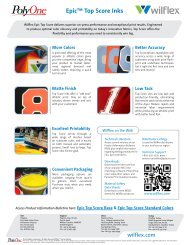

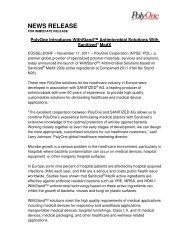

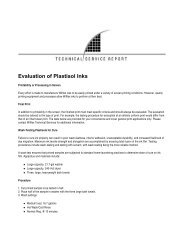
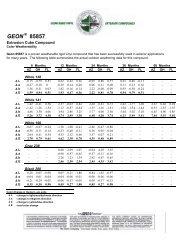
![TPE Injection Molding Guide [PDF] - GLS Thermoplastic Elastomers](https://img.yumpu.com/26329362/1/190x245/tpe-injection-molding-guide-pdf-gls-thermoplastic-elastomers.jpg?quality=85)
